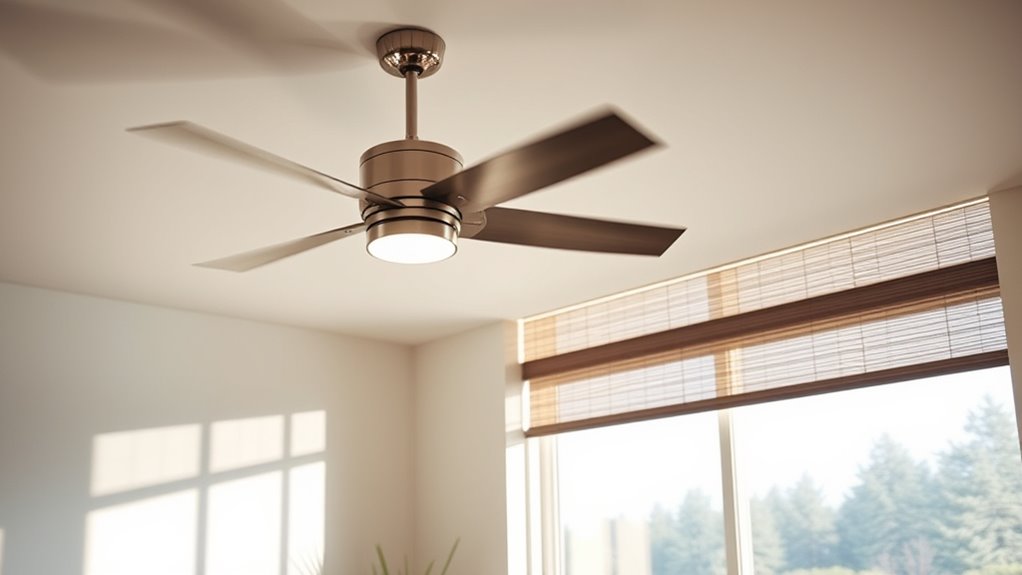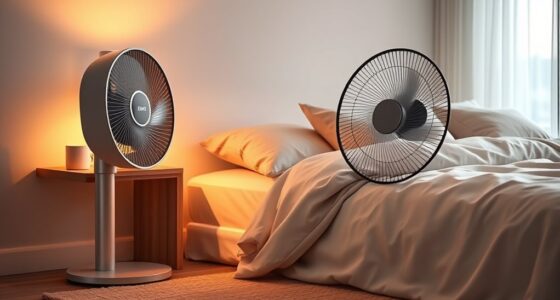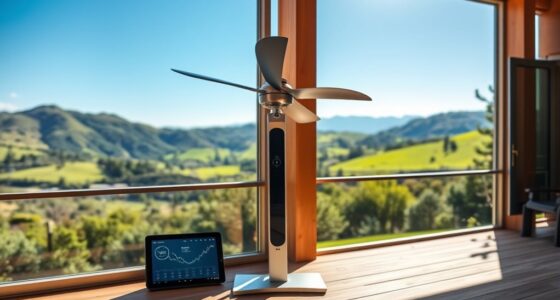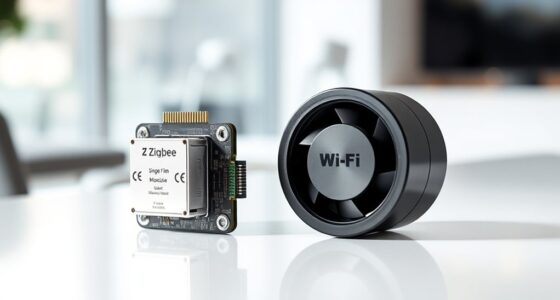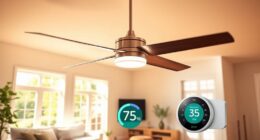Integrating smart ceiling fans with smart blinds and shades involves using centralized control systems that synchronize device operations based on environmental data such as sunlight and temperature. Advanced sensors detect conditions, prompting the shades to adjust for ideal daylight and heat management, while fans modulate speed and direction to enhance comfort and reduce energy use. This coordinated automation improves indoor climate regulation seamlessly. To understand how to set up and refine such systems, explore the detailed configurations and compatibility options available.
Key Takeaways
- Use a centralized smart home hub or compatible control system to synchronize ceiling fans with motorized shades.
- Program automation routines that adjust fan speed and shade position based on environmental sensors and time schedules.
- Integrate sensors for solar radiation and temperature to enable adaptive, energy-efficient coordination between devices.
- Ensure all devices communicate via common protocols like Wi-Fi, Zigbee, or Z-Wave for seamless interoperability.
- Leverage AI-driven automation for personalized comfort by learning user preferences and optimizing fan and shade operation.
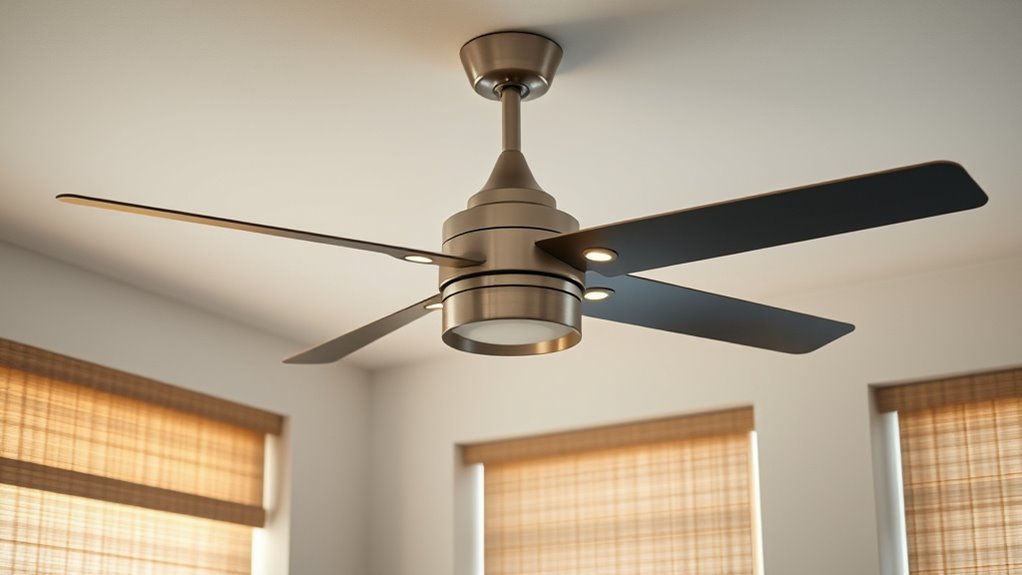
Smart ceiling fans equipped with integrated blinds and shades represent a sophisticated convergence of climate control and natural light management, enabling precise automation and energy efficiency. These systems leverage advanced sensors, motorized mechanisms, and centralized control interfaces to optimize indoor environments dynamically. By integrating fan operation with automated shading, you can maintain a consistent thermal comfort level while minimizing energy consumption. This integration relies on a networked architecture, often utilizing Wi-Fi, Zigbee, or Z-Wave protocols, which allows seamless communication between devices and your home automation hub or app.
Smart ceiling fans with integrated blinds enable seamless climate and light control through advanced sensors and automation protocols.
The core of this integration is the synchronization between the fan’s speed and direction with the position of blinds or shades. For example, during summer mornings, sensors detect increased solar radiation and ambient temperature, prompting the system to lower shades to reduce heat gain. Simultaneously, the fan may operate at a low or medium speed to circulate cooled air, preventing hot spots and maintaining comfort. As sunlight diminishes or external temperatures drop, the system can adjust by raising shades to maximize daylight and warmth, while reducing fan activity to conserve energy. This coordinated response minimizes the need for HVAC system activation, resulting in lower utility bills and a smaller carbon footprint.
Technical implementation involves programming complex automation routines within the control software. These routines consider multiple inputs, such as time of day, weather forecasts, light levels, and temperature sensors, to determine ideal settings. You can set predefined scenes or customize parameters for specific conditions, ensuring that adjustments occur seamlessly without manual intervention. The integration also supports real-time feedback; sensors continuously monitor environmental changes, and the system responds instantaneously, maintaining an ideal indoor climate with minimal latency.
From a hardware perspective, the motorized blinds and shades are equipped with precision stepper or servo motors capable of smooth, quiet movements. The ceiling fan includes variable speed motors with smart controls that can be adjusted incrementally. The entire setup communicates via a central controller or a dedicated smart home system, which processes sensor data and executes commands accordingly. This architecture allows for sophisticated automation scenarios, such as scheduling, geofencing, or adaptive learning, where the system learns your preferences over time and adjusts its behavior accordingly.
Additionally, emerging advancements in AI-driven automation enable these systems to adapt more intelligently to changing conditions and user habits, further enhancing efficiency and comfort. In essence, integrating smart ceiling fans with smart blinds and shades creates a cohesive system that intelligently balances natural light, thermal comfort, and energy efficiency. It requires careful selection of compatible hardware, robust network configuration, and precise programming to achieve optimal performance. When implemented correctly, this integration provides a highly responsive, energy-conscious environment that enhances comfort and promotes sustainability through advanced automation technology.
Frequently Asked Questions
Can Smart Ceiling Fans Operate Independently of Blinds and Shades?
Yes, smart ceiling fans can operate independently of blinds and shades. They’re controlled via dedicated apps, voice commands, or automation routines that target just the fan’s functions like speed and oscillation. You can set schedules or adjust settings without affecting your blinds or shades. This flexibility allows you to optimize room comfort by controlling airflow separately, ensuring personalized climate management even when blinds or shades are set differently or manually adjusted.
What Are the Energy Savings Benefits of Integrating These Smart Devices?
Integrating smart ceiling fans with smart blinds and shades considerably enhances energy efficiency by optimizing indoor climate control. You reduce cooling costs by automatically adjusting shades to block heat during peak sunlight hours, lowering the load on air conditioning. Conversely, in winter, they can open to maximize sunlight warmth. This coordinated control minimizes energy consumption, improves comfort, and extends HVAC system lifespan, ultimately resulting in substantial long-term savings.
How Secure Are the Wireless Connections Between Smart Fans and Blinds?
The wireless connections between smart fans and blinds are generally secure, using encryption protocols like WPA3 or AES-128 to safeguard data. These protocols ensure that unauthorized access is highly unlikely, provided your network has strong passwords and is properly secured. Regular firmware updates also patch vulnerabilities, maintaining security. However, always enable two-factor authentication and monitor device activity to further enhance protection against potential cyber threats.
Are There Compatibility Issues With Existing Smart Home Systems?
You might encounter compatibility issues if your existing smart home system isn’t compatible with the protocols used by the new smart ceiling fans and blinds, such as Zigbee, Z-Wave, or Wi-Fi. Make certain your hub or controller supports these standards. Firmware updates or custom integrations may be necessary. Verify device compatibility via manufacturer specifications before purchase, as incompatible systems can lead to limited functionality or the need for additional bridging devices.
What Is the Typical Setup Process for Integrated Smart Ceiling Fans and Blinds?
You start by ensuring your smart devices are compatible with your hub or app. Then, connect each device to your Wi-Fi, following manufacturer instructions. Use the app’s integration feature to add both the fan and blinds, configuring scenes or automations. Next, assign specific triggers—like temperature or sunlight—so they operate together seamlessly. Finally, test the setup by activating routines, ensuring synchronized operation for maximum comfort and energy efficiency.
Conclusion
By integrating smart ceiling fans with blinds and shades, you orchestrate a symphony of climate control that adapts seamlessly to your environment. This interconnected system symbolizes harmony between technology and comfort, where each component responds instinctively to your needs. As the blades turn and shades adjust, they embody a digital heartbeat—synchronizing airflow and light—creating a sanctuary of precision, efficiency, and personalized comfort, all orchestrated through intelligent automation that transforms your space into a perfectly balanced haven.
